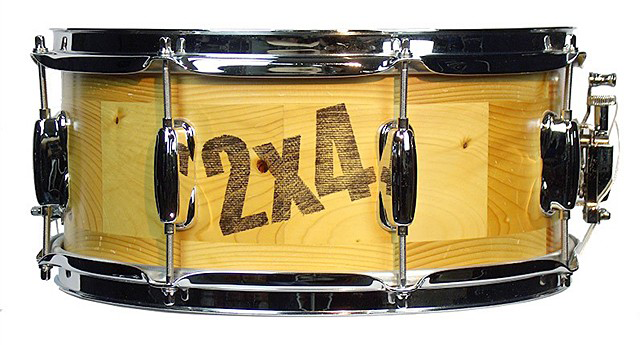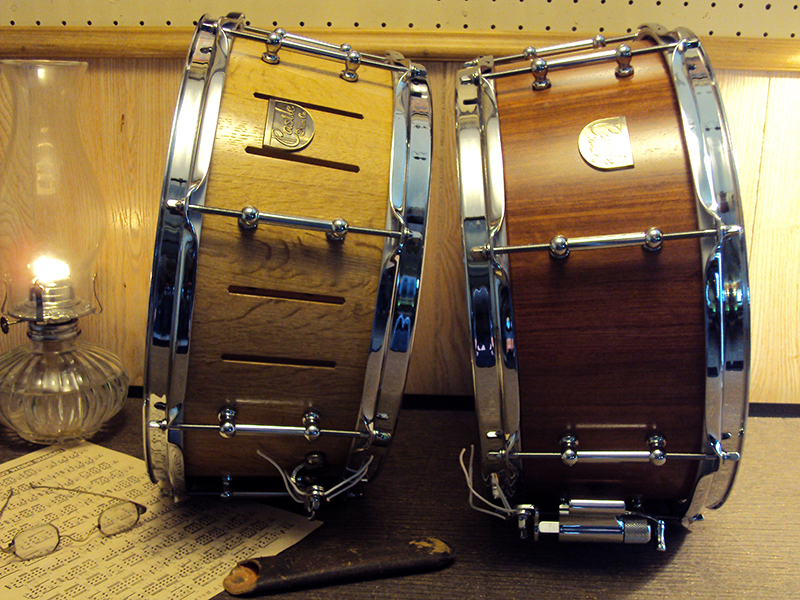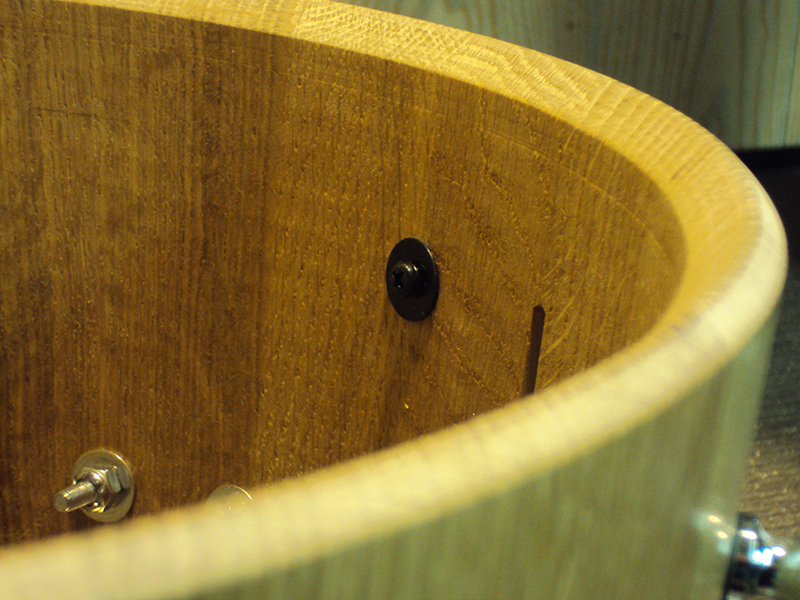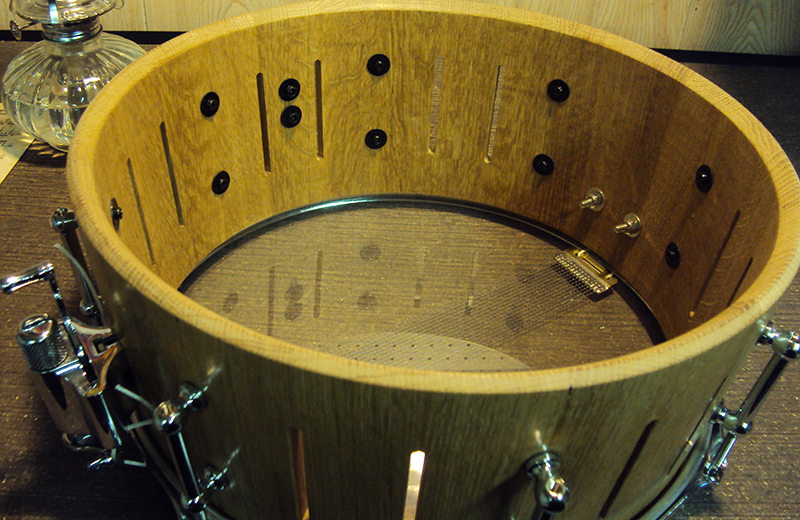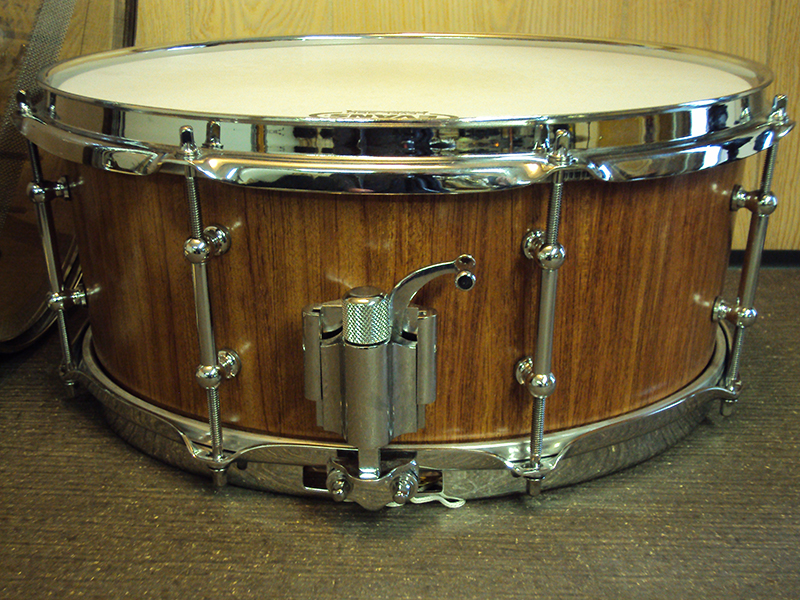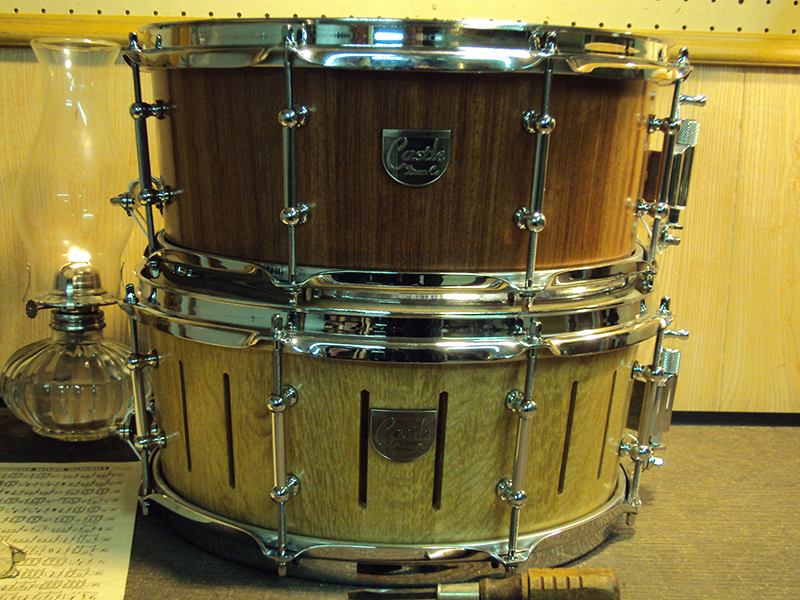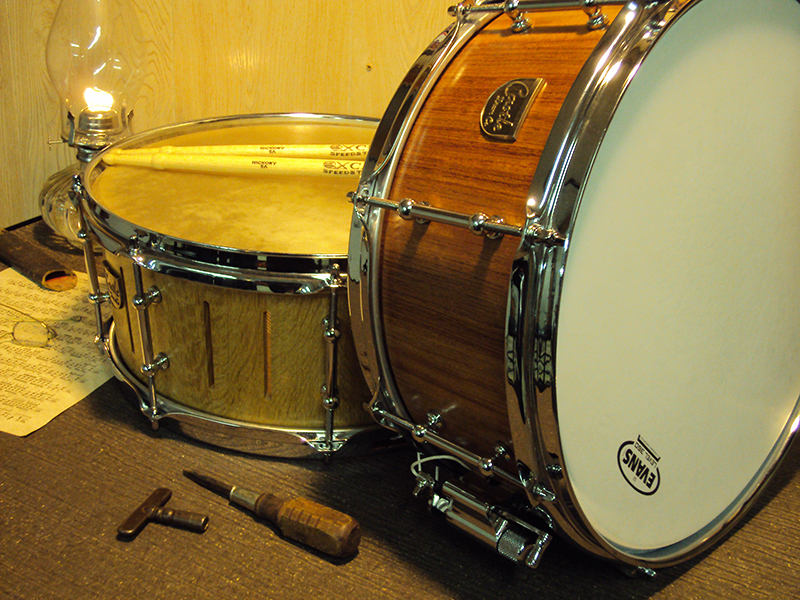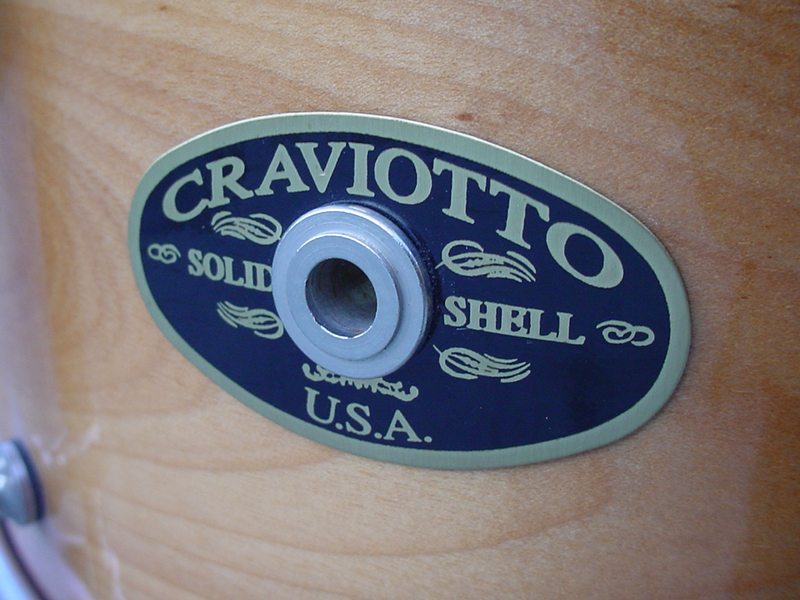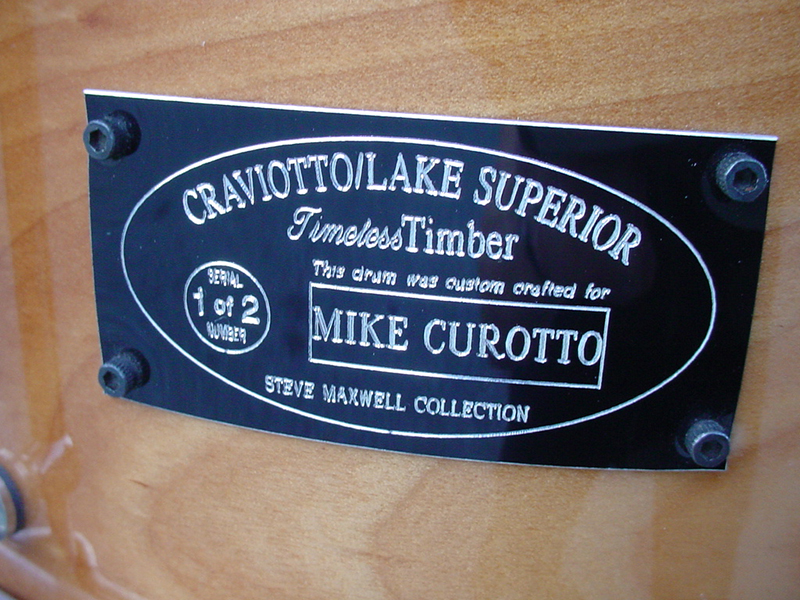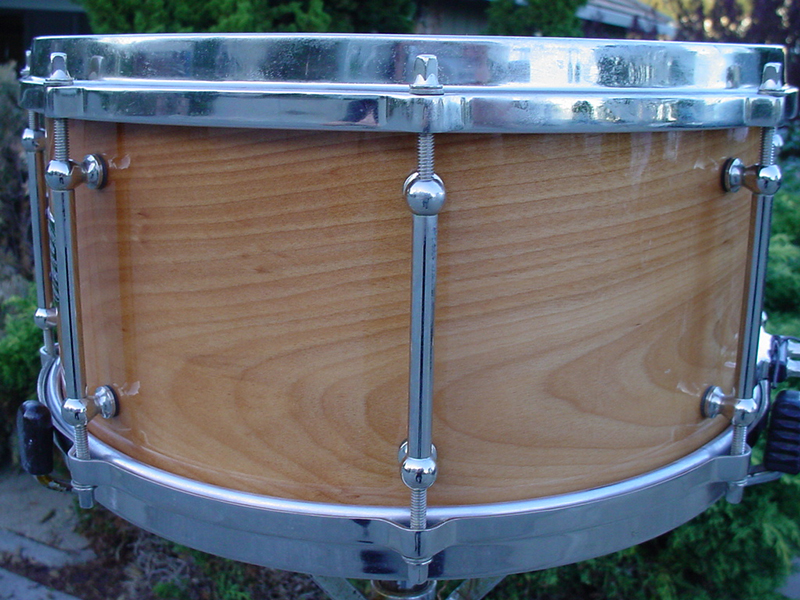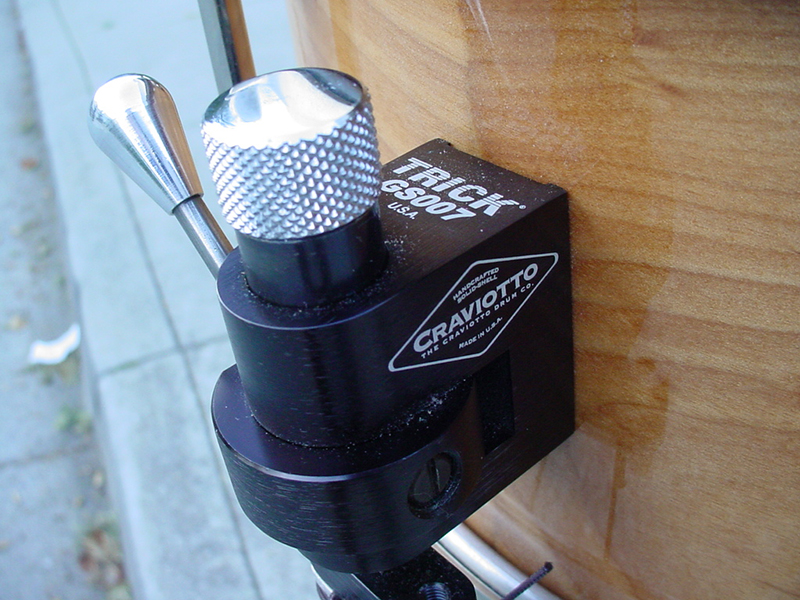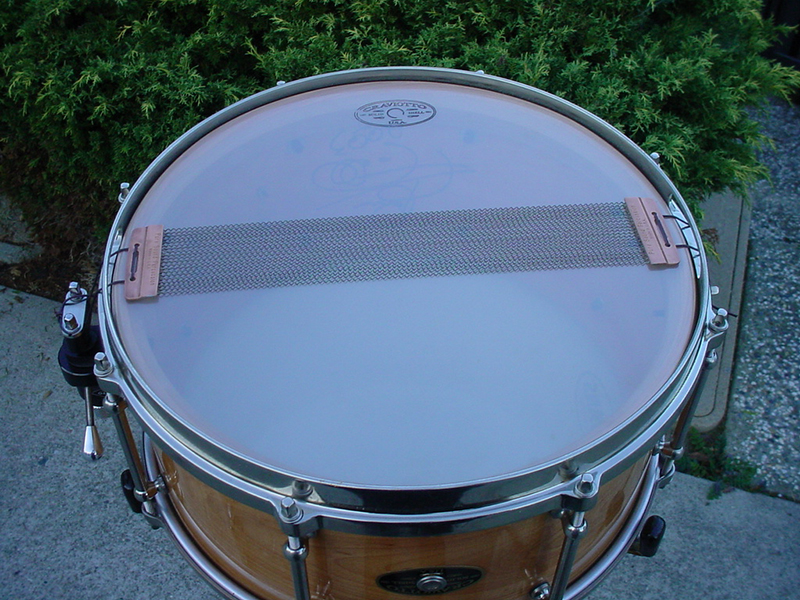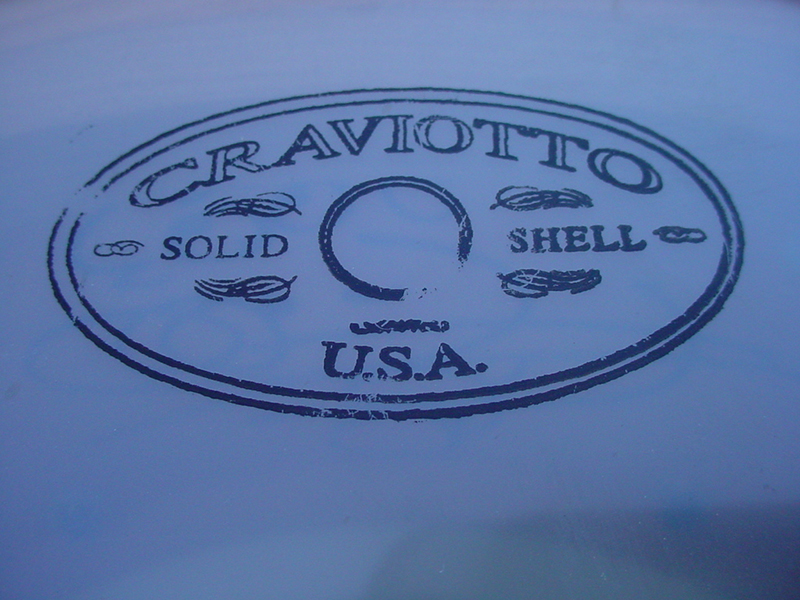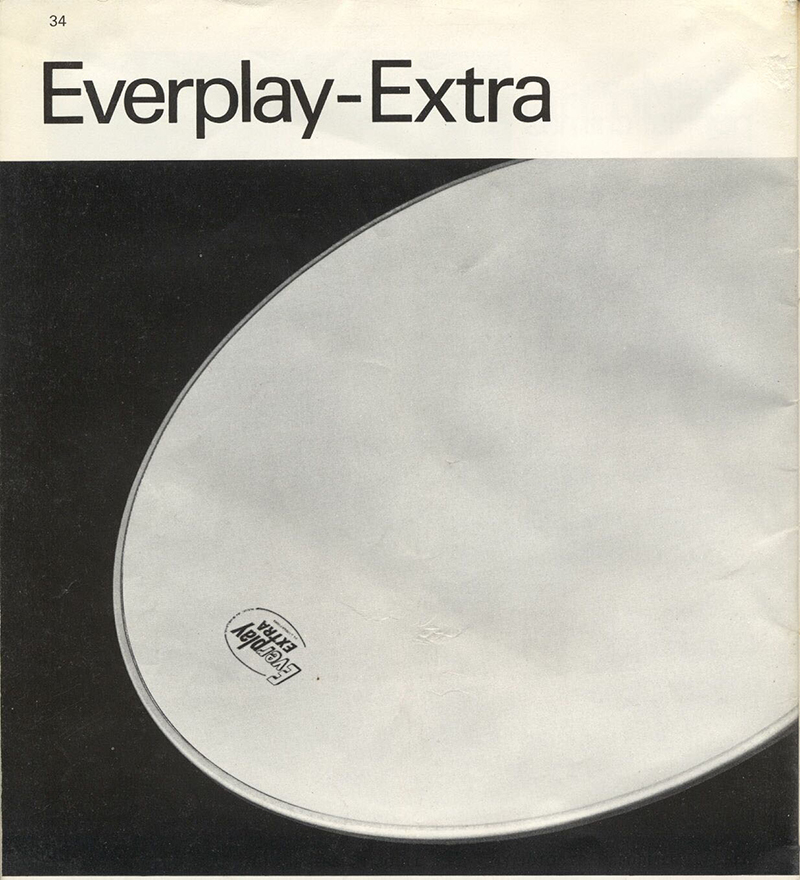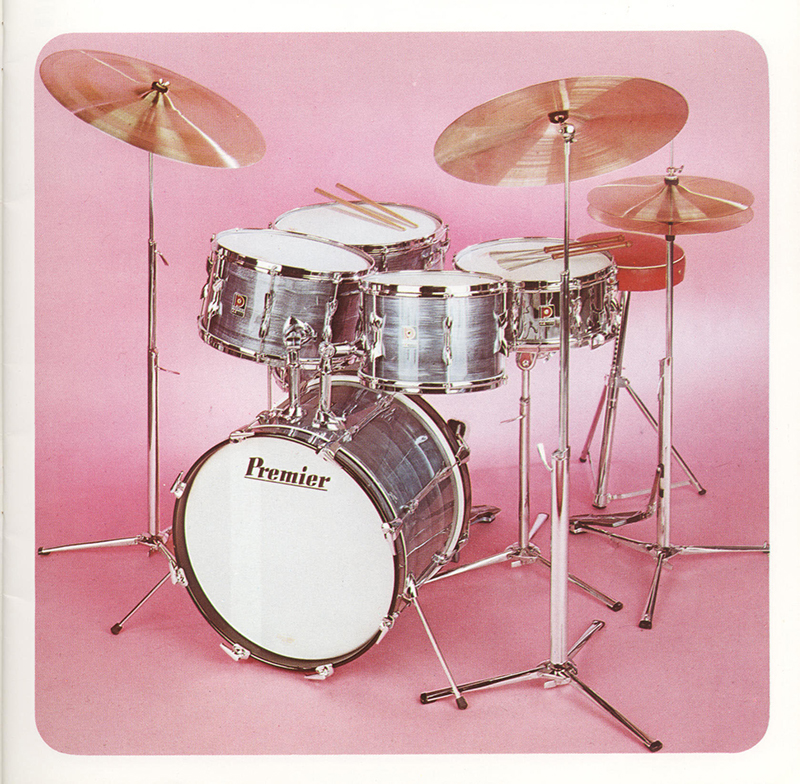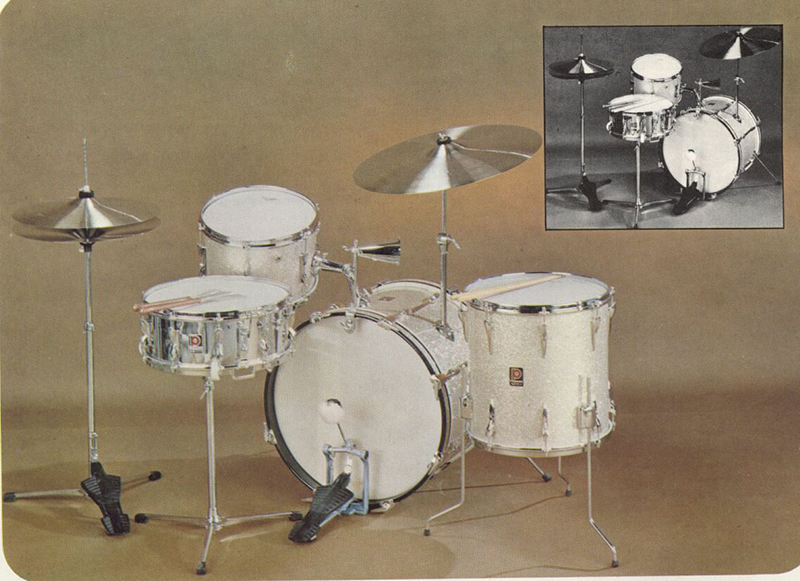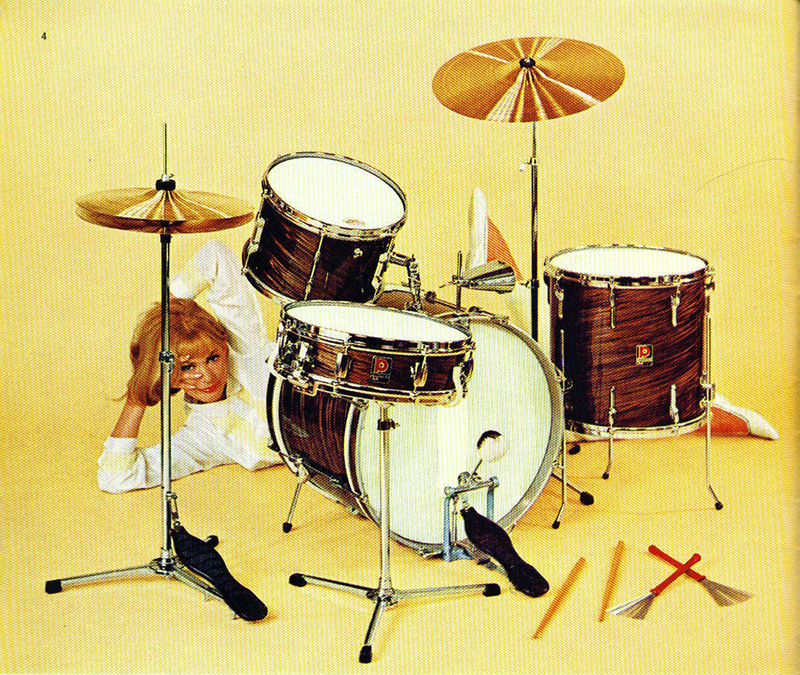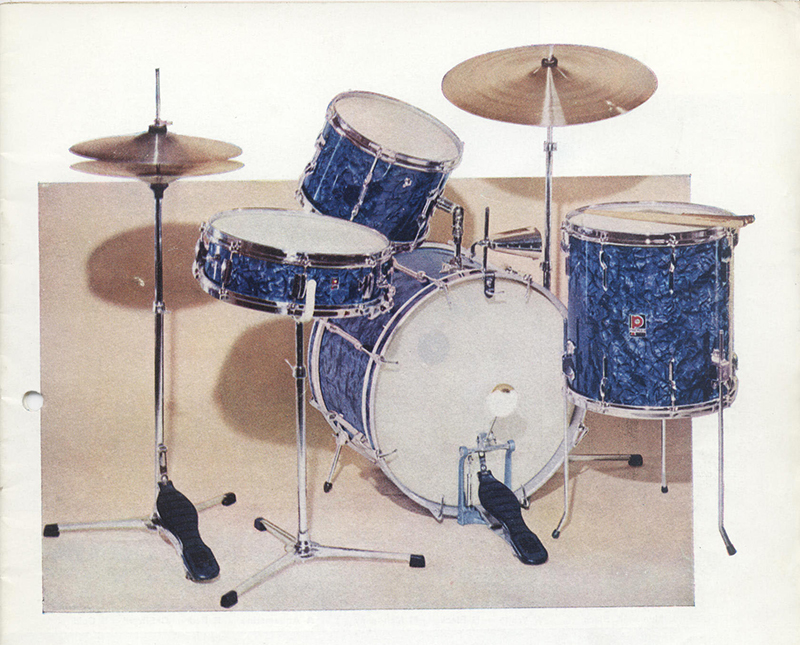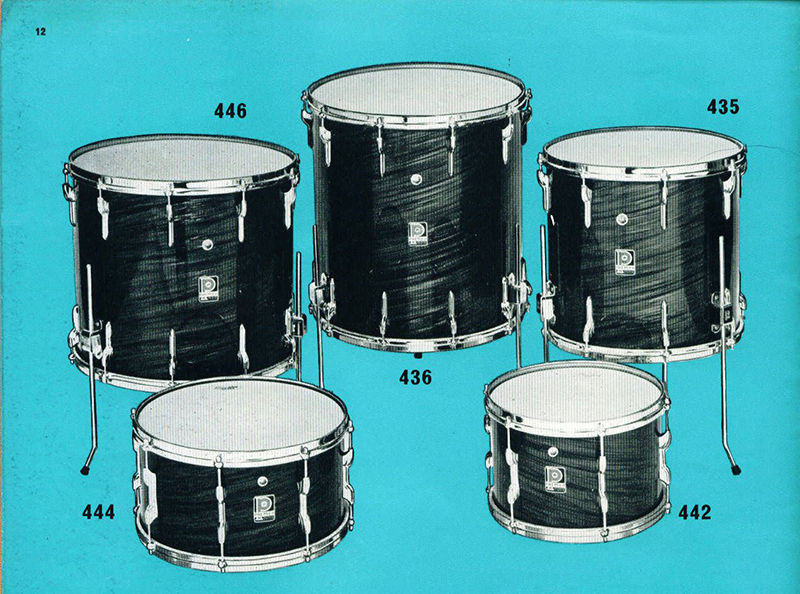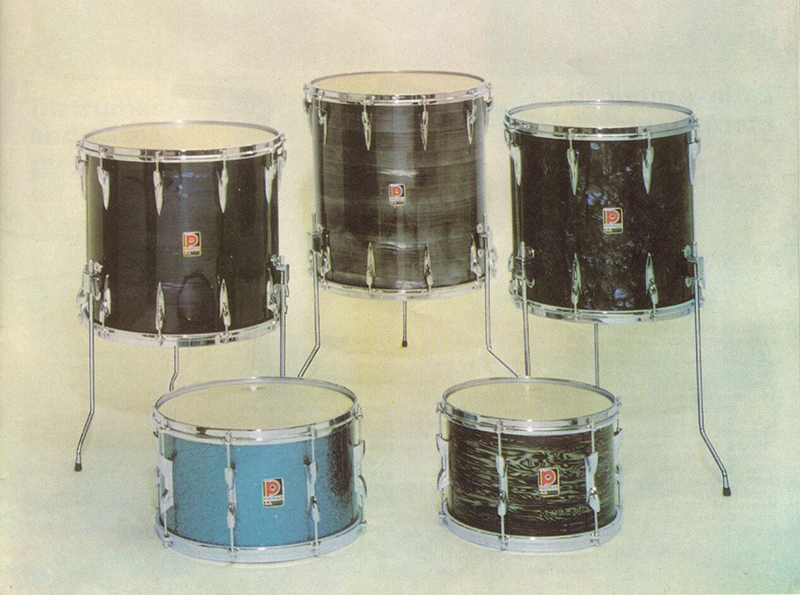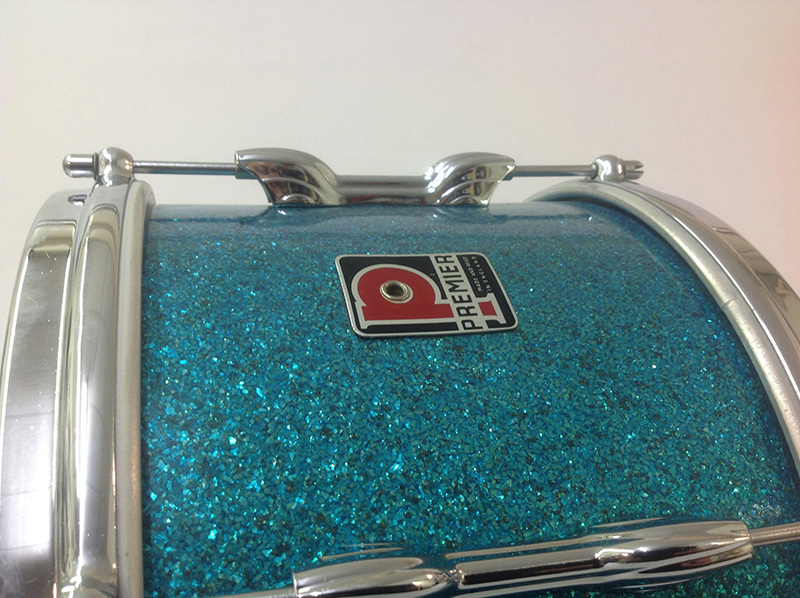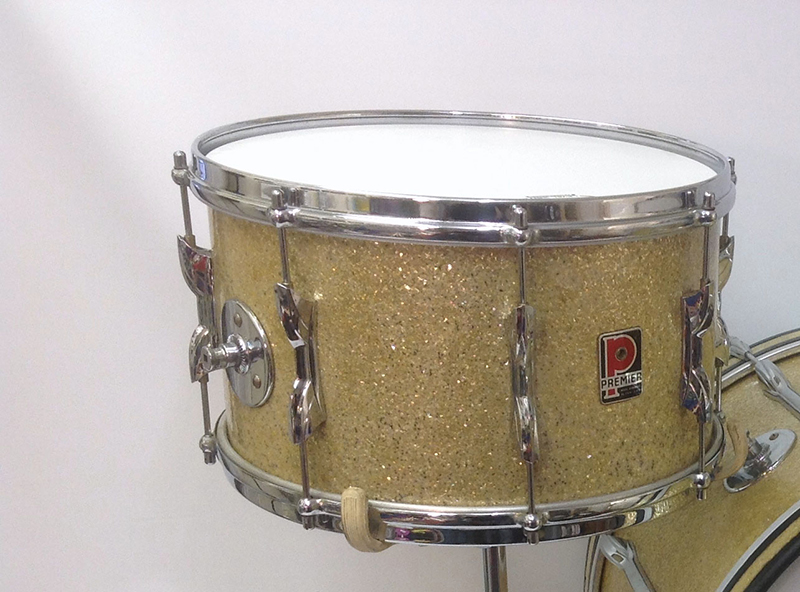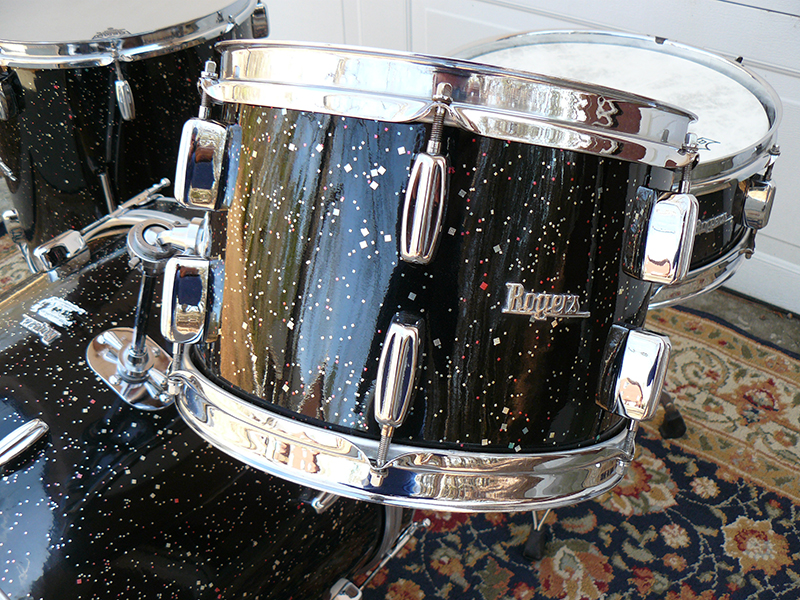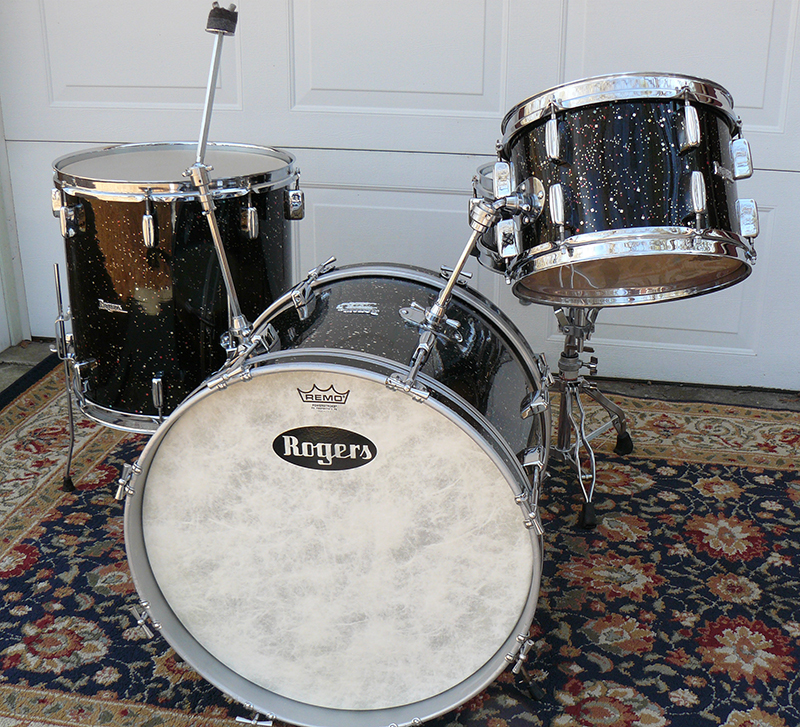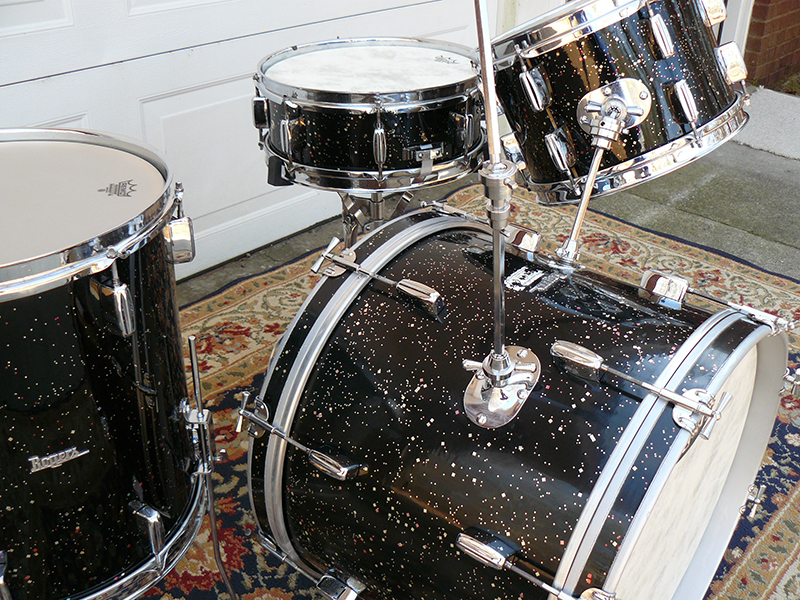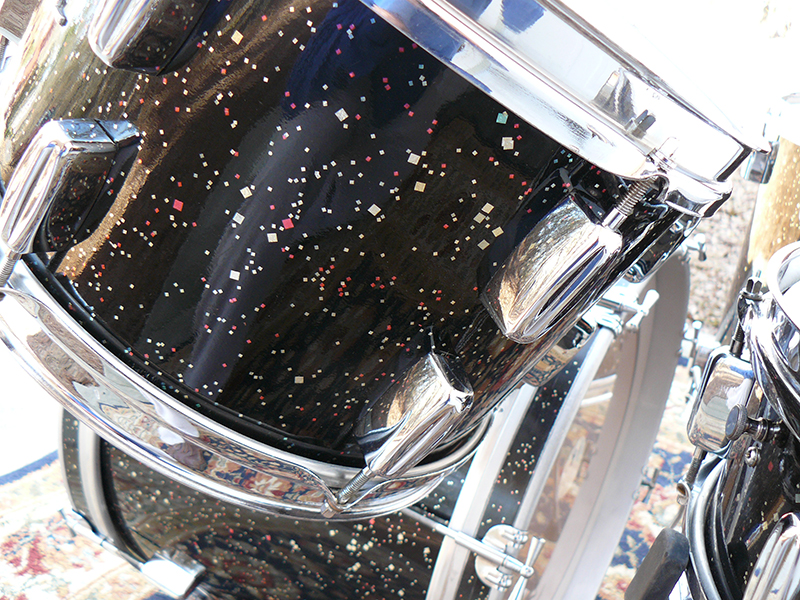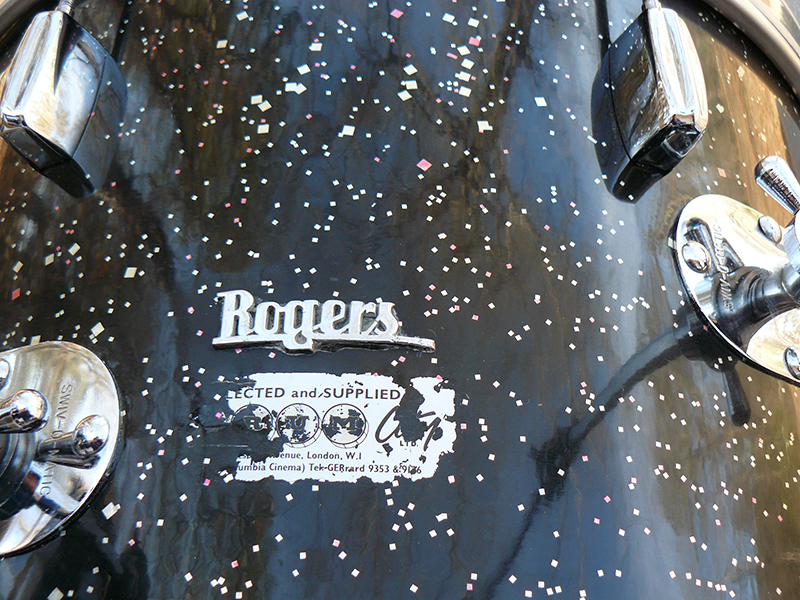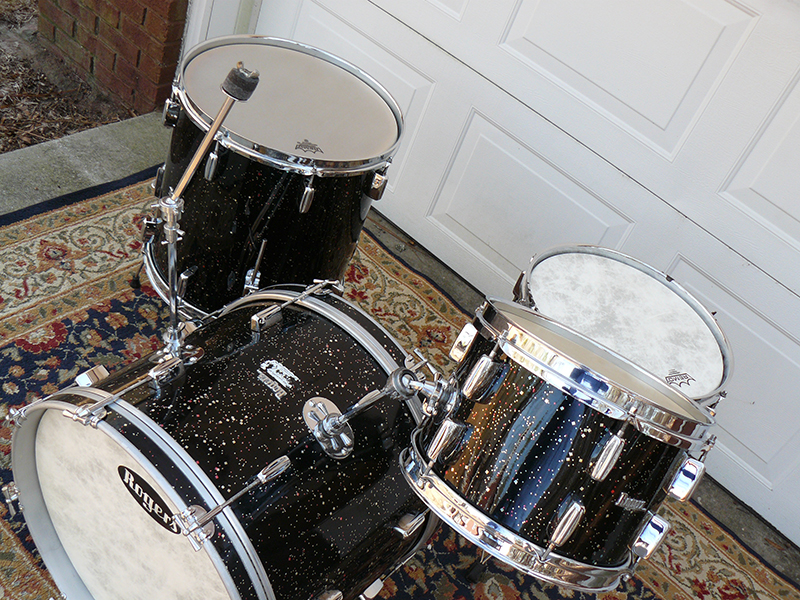Ah, cold, cold, cold, February! You make us want to stay inside and obsess over our vintage drums! Not much to report from the Eastern front but these few tidbits-
Read more2x4 Famous Snare Drum
Famous Drums' "2x4" Custom Snare Drum
Put the Drums in the Organ, Please...
1932-34 Slingerland 5x14 Artist DuAll Model (“Pulley” Version)
By Mike Curotto
Hi All,
A few years ago I was contacted by drummer/educator Ed Soph who wanted some information about this drum. I told him what I knew and after a few months I was able to purchase the drum from Ed. Over the years I have discovered three versions of the Slingerland DuAll mechanism: 1. A center post very similar to if not a direct copy of the Super-Ludwig center post (usually equipped with a Tone Flange). 2. An interior “pulley” type mechanism instead of a center post (no Tone Flange). 3. No center post and no “pulley” mechanism (no Tone Flange). This snare drum has the “pulley” mechanism
The Shell: Green Sparkle from the 1930s is notorious for having black “cancer” spots. Fortunately this drum is cancer free. The finish had the normal years of accumulated schmutz but everything cleaned up and polished up nicely. The interior of the solid maple shell was very clean with no re-ring separation other than a 2” section, no big deal. The shell has normal bearing edges top (no Tone Flange) and bottom . The cloud badge is very clean with a tight grommet. Lastly, a nice factory pre-assembly artifact was found on the interior of the shell...”Nickle DuAll”.
The Hardware: The nickel hardware was in great shape and was very easy to clean and polish. There were a few errant tension rods but I had the era-correct replacements in my parts stash.
The internal DuAll “pulley” mechanism is clean, well built and looks kind of artsy. The mechanism is smooth, works well but is not as solid as the center pole version that brought on the patent lawsuit by Ludwig & Ludwig. I’ve included interior and exterior photos of this version of the DuAll mechanism. The reader will clearly see the similarities to the already patented L & L Super-Ludwig mechanism of the same era. The manufacturer’s cartouche markings on the snare gates are “L” and “LL”.
The Slingerland Artist DuAll Model was only in production for approximately two years and due to this very limited production run Slingerland DuAlls are extremely rare. As far as my snare drum collection goes, my un-scientific guesstimate based on the number of Slingerland DuAlls I own vs. the number of L & L Super-Ludwigs I own is about 15:1 meaning for every DuAll I own there are 15 Super-Ludwigs that I own. If we look at the more realistic bigger picture out there in the collecting world my guestimate is more like 100:1. That’s just my very un-scientific observation. As always, feel free to weigh-in on the subject as I look forward to your comments and added information.
A nice Frank’s Drum Shop calf batter head, Slingerland slunk head and the original snares rounded out this cleaning/restoration.
Enjoy! Mike Curotto
Neal Morse Band, featuring Mike Portnoy - Alive Again Tour
THE "ALIVE AGAIN" TOUR - FIRST STOP, NASHVILLE! The Neal Morse Band will be performing their much anticipated debut album, "The Grand Experiment." The band, featuring award-winning drummer Mike Portnoy, will play ONE NIGHT ONLY in Nashville at Rocketown - Saturday, February 21st!
The Neal Morse Band (feat. Mike Portnoy) Saturday, February 21 at 7:30 PM Rocketown (White Building) - Nashville, TN
TICKETS ARE AVAILABLE ONLINE ONLY AND WILL SELL OUT! Visit www.rocketown.com/events for tickets and more information.
The Neal Morse Band will be hitting the US, Canada and Europe for a winter tour in 2015 and the complete event listing can be found at www.radiantrecords.com.
Castle Drums
Growing up in the shop of a Master Craftsman and Industrial Arts teacher, my Dad taught me a lot about making and fixing things. I learned about metal, leather, printing, mechanical drawing, and woodworking, among many other things. But the most important thing he taught me was quality. While making my rounds at the Nashville Drum Show, I saw many drums that were made with top-notch quality. But even amongst all the quality instruments that were present, some stood out a little more than others.
As I approached the Castle Drum Company’s booth, I at first thought I needed to get more sleep because the drums seemed a bit skewed. Taking a closer look I realized that my vision was fine and the drums were indeed, a bit skewed. David Cheney, the Master Craftsman behind Castle Drums, had come up with something special and a bit different. David had spent over a quarter of a century in fine woodworking as a maker of cabinets, building case work and furniture. Working with odd shaped and intricate pieces, his ability dictated a higher level of thinking about wood and the possibilities therein.
As many of us find as we become older and more proficient in life, we tend to start to figure out what we like and how we want to spend our time. David decided at one point that combining his love of woodworking and drumming might pacify that angst. After all, drums certainly can be made of wood. The one thing that he knew was that he did not want to be just another guy out there painting and assembling drums: he wanted to set himself apart from the rest of the herd. For that, David would have to dare to be different.
Keeping some of the principles of basic physics in mind, he rationed that if you could channel the sound waves of the batter head down to the snare head in a more efficient manner, you would have a more resonant snare response. Turns out he was right. By funneling the sound waves by way of a slightly conically shaped shell, that energy would become somewhat concentrated onto the snare head. With the application a vertical stave construction shell, the grain of the wood is also in turn aiding in directing the flow of sound waves toward the bottom snare head. This inner vertical grain direction also contributes to providing a little “extra” in bringing out the low-end fundamentals of the shell.
David sent me two drums to review for Not So Modern Drummer magazine: The Keystone and the Watch Tower models. Both drums were very similar but couldn’t be more different in some respects. Each shell had a 7/16” thick stave construction, six inches deep with a fourteen inch batter head. However, the shell tapered down to a thirteen inch diameter for the bottom snare head.
David told me that they did some sound testing with results indicating an average of “20% more bottom head movement, and about three decibels more off the resonant (snare) head than other drums.” These drums are very snappy and produce a great snare response with lots of volume.
The hardware on each drum was chrome plated and included triple flanged hoops, an RCK throw-off and butt, as well as tube lugs. Snares were 16 strand and Evans heads were applied top and bottom. The vent hole was left un-reinforced. Both drums came with very nicely worked 45 degree bearing edges, but, for that “vintage sound,” rounded edges are offered on request.
This Keystone model is made of Bubinga wood, while the Watch Tower drum came in White Oak. Tung oil was applied to the inside of each shell while the outside is nicely lacquered. In playing with different tunings, I thought the Bubinga drum was considerably brighter than the White Oak. The Oak had a much more porous and open grain while the Bubinga was a very tight grained wood; thus resulting in the expected and predictable timbres of each shell. Both drums exhibited a wide tuning range, both high and low. As always, I switched out the plastic heads for pre-mounted calf-skin heads from CT Pro Percussion. The calf skins worked out really nice as they added that warm and earthy sound and feel they’re known for.
I find both drums exceedingly versatile in application. However, the main difference in the two models was that the Watch Tower model has a series of vertical slits in the shell. This plays well with another basic principle of the physics of sound associated with drum design and engineering. Drums are thought to usually project sound mostly from the top and the bottom heads, throwing the sound vertically up and down. They do, however, have an inherent tendency to throw the sound horizontally through the shell. In opening up the lateral sides of the shell via the slits, the Watch Tower drum distributes the sound in all directions. My initial reaction to this is that I think this particular model is exceptionally well suited to the environments of orchestra, concert band, jazz or any “un-miced” small group situations.
The Castle Drum Co. uses a variety of hardware to choose from and includes, but not limited to: RCK, Trick and Dunnett throw-offs, die cast and triple flanged hoops, a variety of lugs, snares and heads. Wood ranges from maple, white and red oak, birch, ash, and mahogany. For something special, try an exotic wood such as zebrawood, purple heart or bubinga. If David can find it, he just might build you your next favorite drum in your choices of dimension and hardware.
I find these drums are in fact fun to play and easy to tune. They tune like a fourteen inch drum but snap like a thirteen. The stick-to-head response is really nice, offering an ease in playing involved passages at lower volumes. Back-beats are exceeding fat and full of rich snare sound. Sensitivity of snare response at the lower volumes is again, very good. As far as the higher volumes: they’re loud!
One of the more surprising and pleasant characteristics of the solid shell was that the effective strike zone was at least double the diameter of most other drums I’ve played. This certainly makes the drum much more forgiving than many if a player tends to play with a wider, wilder strike-zone. The slotted shell (Watch Tower model) did not have quite as wide a strike-zone as the solid shell due to the characteristics inherent to the open design, but was still exceedingly responsive across the head non-the-less.
In examining the Keystone model made of Bubinga wood in particular, I had a very hard time locating the individual wood segments as the joints are tight and the grain is matched as close as possible. After giving these Castle Drums a good go, I would really like to take a look at the furniture David Cheney makes. If the quality is even close, I think anyone who has any of his work must be very pleased. The craftsmanship and quality on these drums is of a very high standard. David’s passion and enthusiasm is very evident and the pride he puts in each drum is extraordinary.
Take a minute and visit the Castle Drum Co. on line. There is a very well made video with David in the shop and more models and options to ponder. If you’re looking for something unique and well made with extreme snare sound and response, not-to-mention a really big, fat back-beat, these drums deserve some real consideration.
From Lancaster County, PA…....Thoughts from the Shop.
Brian Hill
2003 6.5x13 Craviotto/Steve Maxwell Collection Birch Lake Superior Timeless Timber Model
Hi all,
Here’s a snare drum that I’ve had for a while. A good friend of mine was the original owner and sold the drum to me about 10 years ago at the 2005 Chicago Vintage Drum Show.
This is a very rare, special order Craviotto snare drum that was part of the Steve Maxwell Collection (Steve is the world’s largest Craviotto dealer). Only two were made in 2003; #1 is in my collection and #2 is in Sweden last I heard. The story is that the original owner (and possibly the collector in Sweden) wanted a Craviotto Lake Superior Timeless Timber 700 year old solid birch snare drum in a 6.5 x 13 size. The order was placed with Steve Maxwell. I was told by three very reputable sources, Johnny, Steve Maxwell and Joe Kenny that in the process of bending the planks/boards Johnny broke 26 boards in order to get two perfect shells. Steve Maxwell was kind enough to let me quote the “broken boards story” in his own words: ”The deal with the broken boards was this: It isn't just the fact that it is a 13 that makes it hard, (because Johnny does 13s, 12s and 10s all the time with no issues). The issue was that it is specifically the Timeless Timber that made it almost impossible to bend a 13. The reason is that the Timeless wood is exceedingly hard from being under pressure in the lake for about 100 years. As a result, the 14 was really the smallest diameter that could be rolled without it becoming excessively wasteful due to broken boards.”
2003 6.5x13 CRAVIOTTO/STEVE MAXWELL COLLECTION BIRCH LAKE SUPERIOR TIMELESS TIMBER
The Shell: The solid birch shell has the typical Johnny Craviotto craftsmanship that he is famous for. The interior is signed and dated 2003. After I bought the drum I asked Johnny if he would authorize a new/updated name plate for me. He came through like a champ.
The Hardware: I’m not sure about drum #2 but this drum has nickel plated hardware, die cast rims and a Trick strainer with the Craviotto logo.
The drum has an Evans G1 batter, Craviotto/Remo snare side and Pure Sound 20 strand wires. The drum has a great “pop” to it and is used all the time in my drum studio.
I felt that this very rare Craviotto snare drum should be shared with my friends, fellow collectors and the vintage drum community.
Enjoy! Mike Curotto
Vintage Drum Heads
With vintage English drums a common enquiry is ‘are my drums pre-international size’?
There is a fair bit of confusion over which English drum manufacturers made shells slightly undersized or oversized, and even then there are misconceptions over which size drums are affected. Here I hope to clarify this for you and give some tips on how to determine if your vintage English drum set takes regular sized heads, or is indeed in ‘funny sizes’!
Premier made pre-international sized drums in a 20, 10, 12 and 16 (metric sized shells) on all sets pre-1967. All other Premier drum shells should be standard (international) sized, although there are exceptions (notably larger bass drums pre 1960, that were non-standard sized and fitted with calf heads – 22,24,26 etc). Premier made their own plastic drum heads ‘Everplay’ and ‘Everplay extra’ in the UK, but its worth a mention that in the 1966 catalogue they do an ‘American sized 12”, and 16” head and were manufacturing 13” heads although they didn’t have any 13” toms on their sets.
The actual measurements of pre international drums are as follows:
10” = 9 5/8” actual diameter 12" = 11-7/8" actual diameter 16" = 16-5/16" actual diameter 20" = 19-5/8" actual diameter
Sometime between 1968 and the early 1970’s all Premier shells became international (standard), and you can generally tell by the badge and kit set up. The 1968 Premier catalogue features a mixture of old and new set configurations but by 1972 all sets featured display configurations with regular shell sizes. It is in these intervening years that sets came out of the factory with just about every combination of standard and pre international sized drums. Typically there was a backlog of pre-international shells in the factory which made it into kit set ups, so many kits between 1968 and 1972 have a mixture of international and pre international shells, some with the earlier 1960’s badge, lugs and fittings, some with the later. It’s not unusual to have a kit with an international size bass drum and pre international 12 and 16 toms and often with a mixture of badges and fittings/mounts.
In the 1968 catalogue, Premier introduced the 14 x 8” tom (sometimes referred to as the ‘tuna fish can’ or the ‘pancake tom’) and its to be noted that this was standard sized. By 1972, Premier had introduced the 13 x 9” tom and from then all drums that came out of the factory were standard sized.
If in doubt when looking at a kit to buy, it’s worth noting that Pre international floor toms are always 10 lug, whilst the international shells were 8 lug. With the 12 x 8” tom and 20 x 14” bass drum, the lugs and badges are usually a good indication. If in doubt, its best to measure the shell’s diameter with the head off!
It should be noted that all Premier snare drums are a standard 14”.
Remo are the only manufacturer of pre-international heads, but now produce quite a range; coated and clear Ambassador as well as clear pinstripe are currently available. They will however make anything to order, in any size, so contact your dealer if you fancy something else or have an unusual size bass drum. I recently had some pre international sized Fibreskyn heads on a special order and have some other pre international head options coming soon.
Other 1960’s English drums often require pre-international heads – Dallas (Carlton, President), Olympic, John Grey (Autocrat, Broadway) and some of their snare drums are slightly under or over 14”. Currently there are no heads available off the shelf for these snare drums, but as mentioned Remo will make heads to fit.
It’s worth noting that both Boosey & Hawkes (Ajax, Edgeware, Stratford), Beverley and Hayman never made pre-international sized drum shells so standard heads will fit these drums. I always have Remo Pre international heads in stock at Nick Hopkin Drums and can have anything made to order. Drop me an email if you want to discuss specifics for your set, or head options.
1960 English Rogers Set
It is hard for me to believe we are already in to February. Where did January go? My Mother told me when I was young and wishing for my birthday, Christmas, or school to be out that time would go a lot faster when I grew up. She was right, as always, and time now really get away in a hurry. I am looking forward, but not wishing my life away, to some great drum shows this year. I hope you can attend one in your area this year. Keep watching for the places and dates to be listed here in the magazine. Getting together with other vintage and custom drum collectors and players is always fun and educational. I am constantly learning information about vintage drums from my drum collector friends. A lot of my contacts and friends were made at drum shows.
I decided to feature a set this month for your enjoyment that I recently acquired. It's an early 1960s English Rogers set in rare Madi Gras finish. I have wanted a Rogers or Slingerland set in Madi Gras finish for years. I just love that finish. By the way, Madi Gras is this month in New Orleans. I've never been to Madi Gras, but I have that trip on my bucket list, but back to my desire for a Madi Gras drum set. I have been looking for a Madi Gras set to add to my collection, and as I was searching E-Bay a few weeks ago a set was there for sale. I really wanted them and had decided to place a bid when the end of the sale came around. I usually wait to bid until the end of the sale. I have jumped in right at the beginning, but usually I wait. Maybe you could leave a comment and share your E-Bay bidding strategy. The Madi Gras set on E-Bay was a Rogers set and that was fine with me. It's no secret to my readers that I love Rogers drums. While I was watching that set, another Rogers Madi Gras set showed up on Facebook. The set for sale on Facebook was the English Rogers set I am showing you. Yes, I made a deal with the seller and he shipped them to me from Canada. I am so excited about them.
English Rogers drums were made in the 1960s at the Boosey & Hawkes drum factory in London. They had Ajax three ply shells with reinforcement rings. The interiors are clear coated not painted like American Rogers. The lugs are Bread and Butter style, and the mounts are Swivomatic style, but they are different from the USA parts. The Madi Gras finish is also different from the American version, not as busy. The script logo badges also look different. The sizes of this set are: bass drum 20"X15", floor tom 16"X16", mounted tom is 12"X8", and the matching snare is 14"X5". Many of you know that Dave Clark of the Dave Clark Five played English Rogers drums. English Rogers drums were not a huge success, but they are very cool drums. Many collectors want to have a replica of John Bonham's set or a Ringo's set. I would like to have a red sparkle English Rogers set with a Dave Clark logo head. He was one of my greatest influences.
My set was owned by a member of the Toronto Symphony who brought them from England. When he returned to England to retire he left the set in Canada with a new owner. There is a cool Drum City London sticker on the bass drum. I was tempted to try to finish removing it. It looks like someone started to take it off but didn't go through with it. I have decided to leave it. It has been there fifty years, and it adds to the story of the drums, so for now the sticker stays. The man who helped me buy these drums from the owner who acquired them from the symphony percussionist was a super guy. He did a great job handling the sale and shipping the drums from Canada to my door. I want to thank him again for the great job he did. Leave a comment if you have an English Rogers set or if you liked Dave Clark Five. Keep looking in those unusual places for a great old drum.
Mike Clark: Words of Wisdom, Part 4
Drummers who use traditional grip...Some people use the index finger over the stick along with the second finger etc. or some guys use the thumb as it is a strong appendage, or kind of open which they used to call rabbit ears...I really think all have certain advantages so why use just one?
OK, My humble opinion. To have a James Brown movie without mentioning Fred Wesley’s name, is like making a John Coltrane film and not mentioning Elvin Jones.
Drummers who want to play jazz, or whatever you want to call it… Check out ‘Do The Math’, an interview with Billy Hart. He talks about history, and his history…The ride beat, which drummers did what, and all kinds of great stuff for musicians who love this music.
Can never stop paying my debt of gratitude to...Philly Joe Jones, Papa Jo Jones, Max Roach, Elvin Jones., Tony Williams, Art Blakey, Tootie Heath, Mickey Roker, Billy Hart, Billy Higgins, Roy McCurdy Lenny White, Kenny Clarke, Gene Krupa, Buddy Rich, Clyde Stubblefield, Louie Bellson, Sonny Payne, Sam Woodyard, Louis Hayes, Jabo Starks, Dave Garibaldi, Bernard Purdie, Clifford Jarvis, and Joe Chambers.... I think about what these cats did and why everyday...Many more, but it would take forever.
Lenny White and I are working on a book about what it was like when he was with Return to Forever, and I was with Herbie Hancock. It also addresses many other things… Even though I lived it, I enjoy the proofing as I’m learning from reading it. At any rate, it’s way cool...Not just drum talk…There’s so much more.
Shelly Manne said…“The ride beat is the easiest and the most difficult thing a drummer will ever play”…Or something like that.


